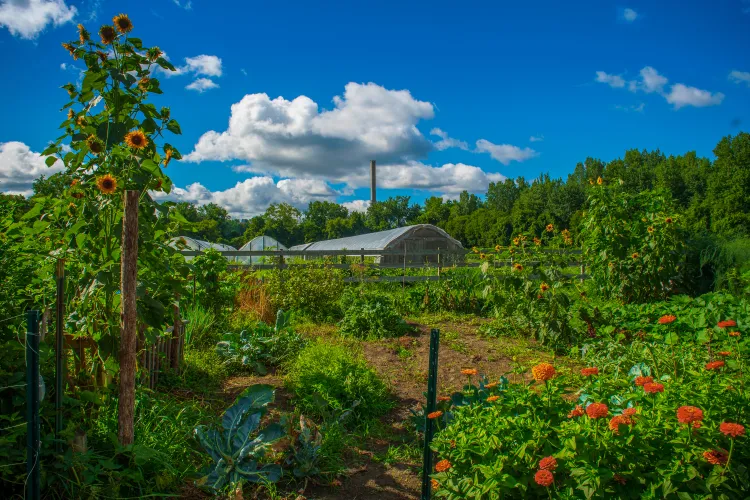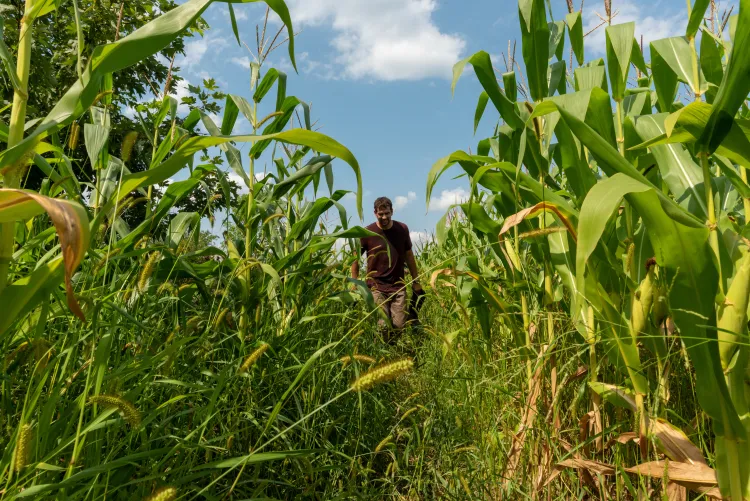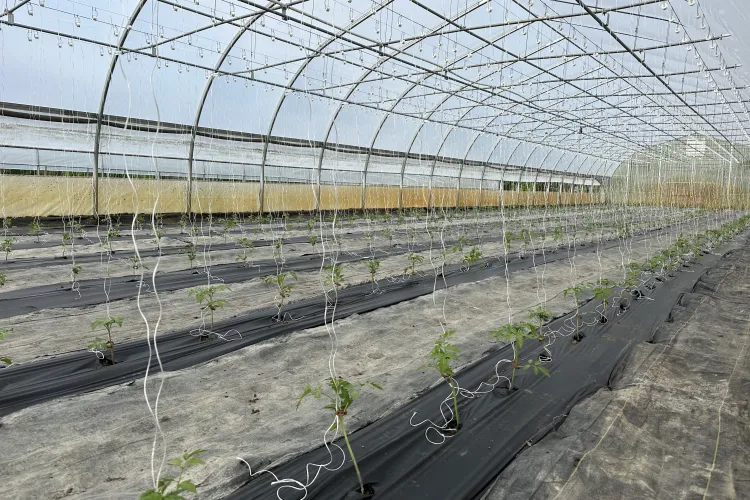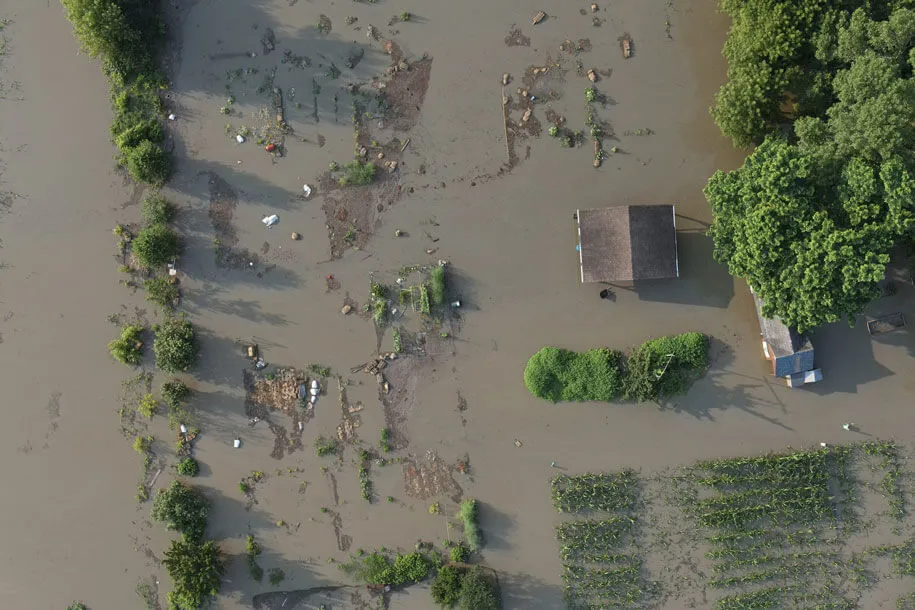Every disaster reveals something about our state of preparedness. The COVID-19 pandemic uncovered deep fissures in the country’s public health system. Heavy rain events like last July tested Vermont’s infrastructure and agricultural sector. And ready or not, with climate change, more will come. That is why University of Vermont researchers are working to build our resilience to extreme events.
One blustery May afternoon, Andy Jones sits at a picnic bench outside his office at Intervale Community Farm (ICF) with a portable two-way radio strapped to his chest. Occasionally, a muffled voice breaks through from the other side of the static.
“All of this is floodplain,” Jones says, gesturing to the fields he has farmed since 1991. Several other farms lease land from the Intervale Center, but ICF is the oldest and largest on the 350-acre site. The farms often share buildings and equipment, and when extreme weather events happen like last July’s flooding, they all feel the effects.
“Many of us had been through it in Irene, which was almost as serious, although July was worse—the difference was between 97 percent and 99 percent,” Jones says with a laugh. “A little bit of it is academic. But it can matter, it did matter to us.”
Veteran growers like Jones knew to start picking crops early and move equipment out of flood prone areas. When the waters receded, ICF was $60,000 in the hole, but it didn’t lose everything. Crews quickly shifted to cleaning up and helping neighboring farms.
“We really relied on each other,” Jones says. “... We all had a ton of community volunteers. I think there is a ton of good will towards the Intervale as a whole and we all benefited from even our neighbors’ good will.”

Most of the time, farming in the sandy soils of the Intervale in Burlington is highly productive such as this 2018 photo suggests. As Vermont experiences increased heavy rain events, farmers like Andy Jones of the Intervale Community Farm are making use of the highest ground on site. Photo by Sally McCay.
Reassuring Growers with Data
Still, coming back from flooding is never easy and depends largely on when and where it occurs. Tropical Storm Irene happened in August of 2011, leaving little time to replant. The July 2023 floods were different. Heavy rains early in the season inundated the spine of the Green Mountains, dumping two months of rain in about 48 hours. Farm fields in some parts of the state remained underwater for weeks.
After a flood, fields are soaked in silt and water contaminated with whatever chemicals and pollutants were upstream, such as sewage, manure, and heavy metals, instantly rendering crops unsalable.
“The FDA is clear you can’t sell things that were touched by floodwaters, but they are not clear on when you can replant,” explains UVM Extension vegetable and berry specialist Vern Grubinger. “So, we are really left on our own to create some level of assurance.”
After the flood, UVM’s Agricultural and Environmental Testing Lab performed free soil testing on 166 flooded sites, including ICF, to flag areas with heavy metals and hydrocarbons or harmful bacteria. Initial tests revealed high microbial counts—but six weeks later the levels were back to normal. This happened after Irene, too. For Jones, this was the data he needed to replant.
“We are organic farmers; We don’t want to make people sick,” he says. “… It was helpful to me and to a lot of the other farmers here to know we are not being ridiculous to say, ‘we can go forward, and the food will be safe.’ We may still lose our shirts because it’s going to flood again, but that is a different problem.”
In recent decades, extreme rain events have increased across New England and first frost, last frost dates are more uncertain. What—and when—to plant can feel like a gamble. In May 2023, a late frost decimated apple and stone fruit orchards across Vermont. A preliminary report by UVM’s Tree Fruit Program found that most growers reported nearly 95 percent in crop damages and projected $10 million in total orchard losses. Two months later, the rain turned on and never seemed to stop.
Over the decades Jones has watched nightly temperatures climb and left crops in the fields later into the fall. While this has boosted productivity, the benefits are offset by upticks in extreme events. Instead of routine rain showers, they get pummeled with heavy rain that pancakes the ground and leaves plants vulnerable to fungal diseases.
“It is hard on the plants,” Jones explains. “… and then we will have long stretches [of nothing]. We are adapting that way. We have invested a lot in irrigation equipment. We keep acquiring it because we need it more and more even though we are often getting too much rain. It’s a crazy oscillation.”
In 2011, Intervale Farm installed a greenhouse installation on a patch of higher ground that would prove prescient in years to come.
“It was the only part of the Intervale that didn’t flood last summer,” Jones says.
Adapting to Change

After Tropical Storm Irene, UVM launched its Farming and Climate Change Program in the Extension Center for Sustainable Agriculture and led by Joshua Faulkner (above). Photo by Joshua Brown.
Nearly every waterway in Vermont flooded during Irene as heavy rain funneled from the mountaintops into the streams below. The storm caused upwards of $700 million in damage to state infrastructure and roads. Afterwards, UVM Extension launched the Farming and Climate Change Program—the first in the nation of its kind.
“For the first six years we were solely focused on adaption, and building resilience,” says Joshua Faulkner, who has led it from the outset. “The past few years the conversation has changed a little bit toward mitigation … and then you have years like this when all the focus is back on adaption. I think floods make climate change really obvious, but it’s really kind of excessively wet years, and that sounds like flooding, but … it’s just saturated soils and so darn hard to get anything to grow, that’s really challenging.”
Vermont has never been an easy place to grow food. Historically, long, harsh winters and summers punctuated with early frosts make for a short growing season. Extreme events like flooding and heavy rainfall are becoming more common as the climate changes, adding more uncertainty to an already risky enterprise. And the effects of these events are felt downstream as soils, phosphorous, and nitrogen wash into waterways. Those are known issues.
“The other piece is when we have erosion it is farmers losing topsoil, and it takes in some cases decades if not hundreds of years to build topsoil,” Faulkner explains. “So, we are losing that agricultural resource that is important for food security.”
Interventions such as high tunnels—plastic or fabric covered hoop structures—can be used to prolong the growing season and protect crops from extreme weather events. They also give farmers more control over growing conditions such as temperature, moisture levels, and air flow. But there are other ways to resilience from climate disasters: building soil health.
Roots in the ground prevent erosion from runoff, increase organic matter in the soil, and soak up some of the moisture during heavy storms, Faulkner explains. And some best practices for building soil health are not exactly scientific breakthroughs in agriculture—methods like cover cropping, crop rotation, and reducing tillage to prevent significant disturbance to soil.
“Those aren’t new things, but we started to recognize their value a little more for soil health,” he says. “Leakage [of phosphorus from fertilizers] after big events is probably always going to happen. … It is hard to manage that when you have the amount of rain you had in the summer of 2023.”
An Offering of Seeds
After the July floods, Becky Maden just wanted to do something to help. A farmer herself, she knew the shipwrecked feeling that comes when seeing months of your efforts underwater.
Maden also knew that in her role as a UVM Extension agent focused on nutrient management she couldn’t do much. She couldn’t cut big checks for farmers who lost everything. She couldn’t create new insurance policies. But she could offer technical advice—and seeds. She was part of UVM’s Extension team that worked with Vermont Agency of Agriculture and Markets to fast-track block grant funding for soil testing and cover crops. The idea: get roots back in the ground.
“Both as a way to hold the soil in place and rebuild it,” Maden explains.
After flooding events, fields may become compacted with silt and leach critical nutrients and turn anaerobic when healthy microorganisms drown in water-logged soils.
“Microbes need oxygen just like any other living being,” Maden says. “And they didn’t have a lot of oxygen last year. … Getting living roots back in there seemed important.”
Specialty block grants from the agency enabled Extension to award about $2,500 worth of cover crop seeds of peas, oats, rye, and vetch to 12 farms. Even so, it didn’t feel like it met the scale of need, particularly to someone who lost hundreds of thousands of dollars in crops and equipment, Maden admits. “It was a little bit of an offering in a sense.”
It was also a practical thing to provide. Cover crops prevent weeds from taking root on bare ground and serve as an indicator that the soil has recovered enough for future plantings.
Maden’s family farm didn’t flood last year. But like many farms across the state, they were saturated with water and reported 30 to 40 percent losses in annual production.
“We got 24 inches of rain on clay soil,” she says. “It was game over.”
Looking Up

Tomato starts at Intervale Community Farm in May 2024. "We are trying to go all in on what we have for the higher grounds,” explains ICF farmer Andy Jones on the strategy to invest in higher ground.
Back at Intervale Community Farm, Andy Jones’ radio crackles as crew members pack up for the day, collecting sandbags and tarps. He considers one last question: is there any good that comes from a flood?
“It’s easy when things are going well just to cruise and to keep doing the same thing,” he says. “A flood does force a little bit of introspection … We changed some things after Irene that were significant. We are going to change some other things after this flood.”
One idea circulating among the team is to build berms around some high tunnels to keep water from seeping in. Some neighboring farms have already shifted to producing salad greens and herbs rather than risk a failed harvest with crops that take longer. Mainly though, ICF is looking up.
“We are trying to go all in on what we have for the higher grounds—put up a few more tunnels on the sections that didn’t flood,” Jones says. “We are going to invest as much productive capacity on the least flood prone land. That is the big thing.”
He heads out back to show where the new high tunnels will stand. We follow a dirt path a hundred feet or so and stand on an indecipherable (to me) island. He pauses to point down slope to where a river flowed across the farm last July. We pass one high tunnel filled with tomatoes planted just hours earlier and a second brimming with baby cucumber starts.
“There is a lot of land down here,” Jones says pointing to a copse of trees in the distance. “And the river, it’s always present, the mighty Winooski.”
We walk back to the parking lot, passing patches of dandelions soaking in the late afternoon sun.
“We can keep doing this as long as it’s working,” he says. “The question that looms is ‘how often does this have to happen for it to no longer really be a viable business model?’ And I don’t think we know, or anybody really knows.”
UVM researchers across disciplines assisted Vermont communities affected by the July 2023 floods. The Spatial Analysis Lab deployed its Unoccupied Aerial Systems Team members to document the extent of flooding and created a rapid drinking water assessment for the Vermont Department of Health. Kelly Hamshaw routinely works with manufactured home communities (MHCs) in planning and recovery efforts using a climate justice lens. Her latest investigation is one of six UVM projects funded after last year’s flooding to better understand the state’s recovery and response.
[Editor's Note: This story was published just prior to the rains of July 10-11, 2024 that caused more catastrophic flooding across Vermont. The UVM faculty and staff mentioned in this piece and in its related story are continuing their work throughout the state.]
